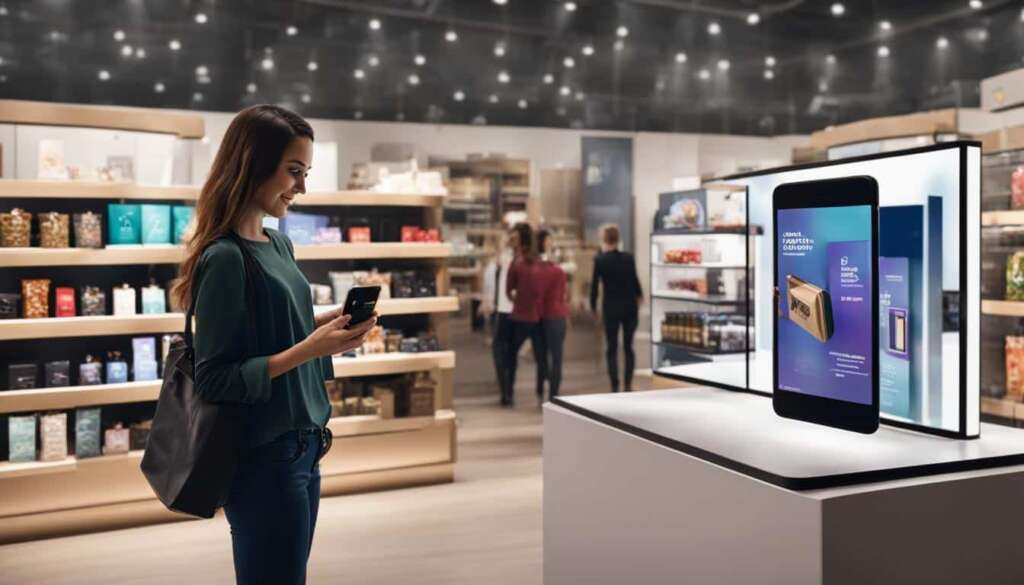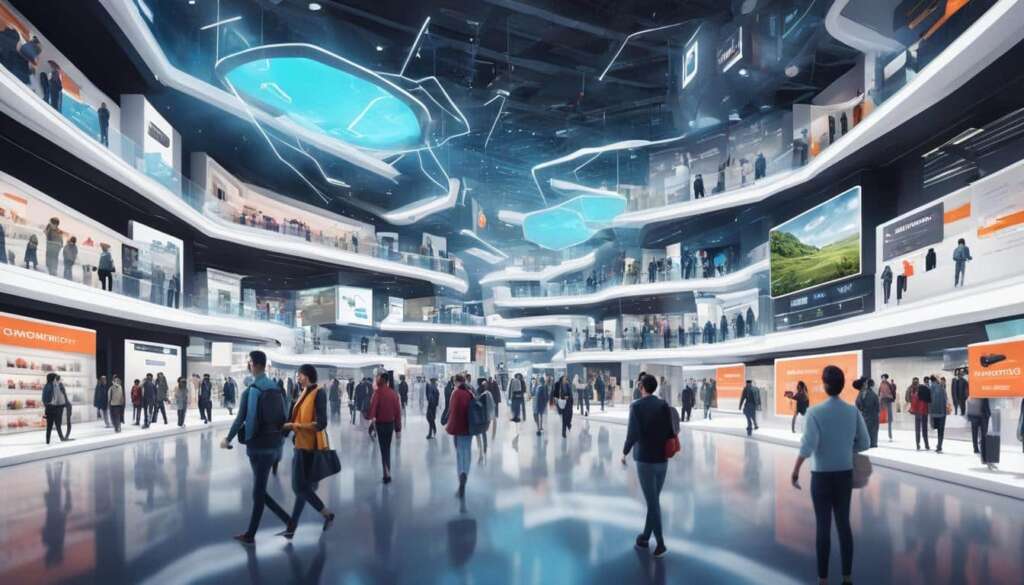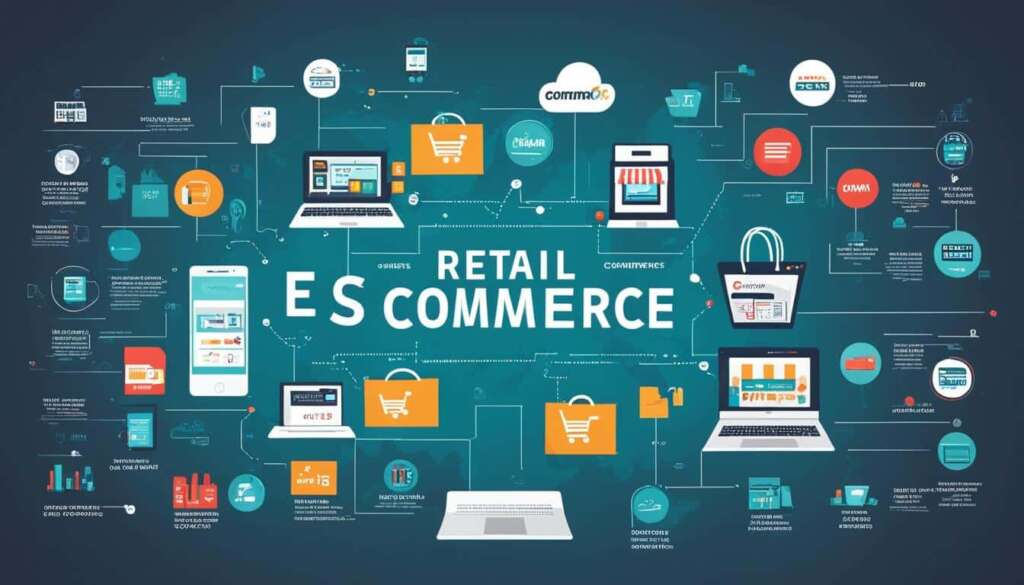Table of Contents
B2C e-commerce is constantly evolving, and staying up-to-date with the latest trends is crucial for online retailers. In this section, we will explore the biggest trends in B2C e-commerce that will shape the future of online shopping. These trends include the use of augmented reality (AR) to enhance the online shopping experience, the growing volume of voice search, the role of artificial intelligence (AI) in understanding shoppers, the importance of on-site personalization, the use of big data for creating personalized experiences, the impact of chatbots on the shopping experience, the rise of mobile shopping, and the availability of more payment options. We will also discuss the concept of headless commerce and its role in driving innovation in e-commerce.
Augmented Reality Enhances the Reality of Online Shopping
Augmented reality (AR) is revolutionizing the way people shop online. With AR technology, shoppers can visualize products in their own environment, giving them a better understanding of the item they are considering purchasing. This is particularly beneficial in industries such as fashion and home decor, where customers can get a realistic sense of how a product will look in their own space.
Imagine being able to virtually try on clothes, experiment with different furniture arrangements, or see how a new paint color will transform a room, all from the comfort of your own home. AR brings these experiences to life, bridging the gap between online and offline shopping.
AR allows customers to interact with products on a deeper level, providing a more immersive and engaging online shopping experience. By simply using their smartphones or other AR-enabled devices, shoppers can overlay virtual images onto the real world, enabling them to see the products in scale and perspective.
This technology eliminates the guesswork that often comes with online shopping. Instead of relying solely on product descriptions and static images, customers can now visualize how a fashion item will fit, how a piece of furniture will look in their living room, or how a new home decor item will complement their existing space.
AR is also transforming the way retailers showcase and sell their products. Instead of relying on traditional catalog-style photographs, brands are now embracing AR to create interactive, dynamic, and visually appealing product displays that allow customers to fully explore each item.
According to industry predictions, the use of AR in online shopping is set to soar. By 2020, it is estimated that 100 million consumers will shop using AR, further highlighting the potential and popularity of this technology.
Benefits of AR in Online Shopping:
- Enhanced shopping experience: AR enables customers to visualize products in a realistic way, leading to better-informed purchase decisions.
- Increased customer satisfaction: By providing a more immersive shopping experience, AR enhances customer satisfaction and reduces the likelihood of returns.
- Time and cost savings: AR eliminates the need for physical store visits, saving customers time and travel expenses.
- Improved product discovery: AR allows customers to discover new products and explore different variations, increasing the range of choices available to them.
AR is undoubtedly changing the landscape of online shopping, offering new possibilities for both customers and retailers. As this technology continues to evolve and become more accessible, it will undoubtedly become a key driver of growth in the fashion and home decor industries, providing an enhanced online shopping experience like never before.
Voice Search: A Growing Volume
Voice search is experiencing rapid growth due to the increasing ownership of smart speakers and the reliance on voice assistants for daily tasks. It is estimated that 75% of U.S. households will own a smart speaker by 2025. This presents an opportunity for B2C e-commerce businesses to optimize their keywords and content for voice search. By understanding how consumers use voice search to shop online, businesses can tailor their strategies to meet the needs of voice search users.
Optimizing Keywords and Content for Voice Search
When it comes to voice search, the key is to focus on conversational keywords and natural language. Voice search queries tend to be longer and more conversational compared to typed searches. Businesses should consider how customers will phrase their voice search queries and create content that addresses those specific queries.
For example:
“What are the best running shoes for women?”
In this case, businesses should incorporate long-tail keywords and phrases related to running shoes for women into their product descriptions and website content to increase their visibility in voice search results.
Tailoring Strategies for Voice Search Users
Voice search users often have different needs and preferences compared to traditional search users. They are more likely to ask specific questions and seek immediate answers. Businesses can meet these needs by:
- Providing direct answers to commonly asked questions on their website
- Creating content that addresses the who, what, when, where, why, and how of their products and services
- Optimizing their website for local searches, as voice search is often used for local queries such as “find a coffee shop near me”
By tailoring their strategies to accommodate voice search users, businesses can enhance their online visibility and increase their chances of attracting and converting voice search traffic.
The Future of Voice Search in E-commerce
The future of voice search in e-commerce is promising. As smart speakers become more widespread and voice assistants continue to improve, more consumers will rely on voice search for their online shopping needs. Businesses that embrace voice search optimization early on will have a competitive edge in the market.

AI Helps Shops Learn About Shoppers
Artificial intelligence (AI) and machine learning play a crucial role in providing personalized shopping experiences to customers. By collecting and analyzing customer data, AI technology enables businesses to gain valuable insights into shoppers’ behaviors and preferences.
With this data, online retailers can create customized product recommendations and enhance customer service, tailoring their offerings to meet individual preferences. The use of AI allows for automation in providing personalized experiences that cannot be replicated in-store, revolutionizing the way online shops engage with customers.
By harnessing the power of AI, retailers can offer a level of personalization that was previously unattainable, increasing customer satisfaction and driving conversion rates. Through AI-driven technologies, online shops can identify the unique needs and desires of each customer, ultimately delivering a more tailored and rewarding shopping journey.
Let’s take a closer look at the benefits of AI in creating personalized shopping experiences:
- Enhanced data collection: AI technologies can collect vast amounts of data on each customer, allowing retailers to gain a comprehensive understanding of their preferences, buying habits, and behaviors.
- Data analysis and insights: AI algorithms can analyze the collected data, extracting valuable insights that can inform product recommendations, marketing strategies, and other personalized shopping experiences.
- Personalized product recommendations: With AI, online retailers can offer customers personalized product recommendations based on their past purchases, browsing history, and preferences. This level of personalization enhances the shopping experience and increases the likelihood of conversion.
- Improved customer service: AI-powered chatbots and virtual assistants can provide real-time support and assistance to shoppers, answering their queries, and providing personalized recommendations. This instant and personalized responsiveness makes the customer service experience more efficient and satisfying.
- Streamlined inventory management: AI technology can assist retailers in managing their inventory more effectively by predicting demand and identifying trends. This ensures that popular items are always in stock, reducing the risk of out-of-stock situations and improving customer satisfaction.
“AI enables online retailers to harness the power of customer data and provide personalized shopping experiences that meet the unique preferences of each individual shopper.” – [Real brand name]
The implementation of AI in e-commerce is rapidly expanding, with more and more retailers recognizing its potential to unlock personalized shopping experiences. As AI continues to advance, we can expect even greater levels of personalization and innovation in the world of online retail.
On-site Personalization Creates Individualized Experiences
Buyers, both B2C and B2B, are increasingly seeking personalized shopping experiences online. On-site personalization uses the insights gained from AI and customer data to create individualized experiences for each shopper. This tailored approach goes beyond generic recommendations and allows businesses to connect with customers on a deeper level.
By analyzing customer behavior, preferences, and past purchases, on-site personalization delivers a unique and customized journey. Whether it’s displaying personalized product recommendations, targeted promotions, or tailored content, on-site personalization creates a sense of exclusivity and relevance for the customer.
This level of personalization has a significant impact on revenue. According to studies, retailers that invest in advanced personalization capabilities can experience a revenue lift of up to 25%. But even those with basic personalization capabilities in place can achieve a revenue lift of 10% or more.
The benefits of implementing on-site personalization go beyond revenue lift. It also enhances customer engagement, loyalty, and satisfaction. When customers feel understood and catered to, they are more likely to make repeat purchases and recommend the brand to others.
| Benefits of On-site Personalization | Revenue Lift | Advanced Personalization Capabilities | Basic Personalization Capabilities |
|---|---|---|---|
| Improved customer engagement and loyalty | Up to 25% | ✓ | |
| Enhanced customer satisfaction | 10% or more | ✓ | |
| Increased conversion rates | ✓ | ||
| Higher average order value | ✓ | ||
| Reduced bounce rates | ✓ |
Implementing on-site personalization requires advanced capabilities that utilize AI and machine learning technologies. These advanced tools analyze vast amounts of data in real-time to deliver highly targeted and relevant experiences to each individual customer.
On-site personalization is not limited to large retailers; even small businesses can implement basic personalization capabilities. By starting small and gradually scaling personalization efforts, businesses can still achieve significant improvements in customer experience and revenue.
Leveraging on-site personalization also allows businesses to deepen their understanding of customers’ needs and preferences. By monitoring and analyzing customer behavior, businesses can uncover valuable insights and make data-driven decisions to further optimize the shopping experience.
Ultimately, on-site personalization is a powerful tool that helps businesses stand out in a crowded marketplace. By delivering personalized experiences that resonate with each individual customer, businesses can create meaningful connections, foster loyalty, and drive revenue growth.

Chatbots Improve the Shopping Experience
Chatbots are revolutionizing the way online shoppers interact with B2C e-commerce businesses. These AI-driven virtual assistants provide automated customer support and replicate the experience of interacting with an in-store sales associate. By incorporating chatbots into their websites and mobile apps, online retailers can enhance the shopping experience for customers, improving satisfaction and boosting sales.
One key advantage of chatbots is their ability to assist customers in finding and purchasing products quickly and efficiently. They can answer commonly asked questions, provide recommendations based on customer preferences, and guide shoppers through the buying process. This streamlined approach minimizes frustration and saves time, leading to a more positive shopping experience.
“Chatbots have transformed the way our customers shop. With their ability to provide instant support, our shoppers feel empowered and confident in making their purchase decisions.”
Chatbots are no longer limited to just customer support. They are emerging as important marketing tools for B2C e-commerce businesses. By using chatbots, retailers can engage with customers in a personalized and targeted manner. Chatbots can collect valuable data about customer preferences and behaviors, allowing businesses to tailor their marketing strategies accordingly. For example, chatbots can send targeted product recommendations, offer exclusive discounts, and inform customers about upcoming sales events.
Additionally, chatbots can be integrated with self-checkout kiosks to further enhance the shopping experience. Customers can complete their transactions seamlessly without the need for assistance from a sales associate. This not only improves efficiency but also reduces the need for physical contact, making it particularly relevant in the current era of heightened hygiene awareness.
Furthermore, in-store marketing efforts are also adopting chatbot technology. By utilizing chatbots, businesses can provide real-time product information and promotions to customers while they are browsing in-store. This interactive and personalized approach to in-store marketing helps to drive customer engagement and increase sales.
Key Benefits of Chatbots in B2C E-commerce:
- Automated customer support, providing instant assistance
- Replicating the experience of interacting with an in-store sales associate
- Efficiently guiding customers through the product selection and purchasing process
- Collecting valuable data for targeted marketing strategies
- Integrating with self-checkout kiosks for seamless transactions
- Enhancing in-store marketing efforts with real-time information and promotions
Mobile Shopping and More Payment Options
Mobile shopping has witnessed a significant rise in popularity, transforming the way customers make purchases. With the convenience of shopping anytime and anywhere, it’s no surprise that mobile devices are becoming the go-to platform for e-commerce. In fact, it is estimated that by the end of 2021, 73% of e-commerce sales will be made through mobile devices.
To meet the growing demand for mobile shopping, online retailers must prioritize creating responsive websites that offer a seamless mobile experience. This ensures that customers can easily browse and purchase products on their smartphones or tablets. By optimizing the mobile shopping experience, retailers can capture a larger share of the market and cater to the preferences of modern consumers.
Furthermore, offering a variety of payment options is integral to improving conversion rates. Customers have varying preferences when it comes to payment methods, and providing multiple options enhances customer satisfaction and increases the likelihood of completing a purchase. One such option gaining popularity is digital wallets. These convenient payment solutions allow customers to securely store their payment information, enabling quick and easy checkout for future transactions.
By embracing the growing trend of mobile shopping and offering diverse payment options like digital wallets, online retailers can enhance the convenience and ease of the shopping experience, ultimately driving higher conversion rates and fostering customer loyalty.
FAQ
What is augmented reality (AR) and how does it enhance the online shopping experience?
Augmented reality (AR) is a technology that allows shoppers to visualize products in their own environment, giving them a better understanding of how the item will look in their own space. This is particularly helpful in industries such as fashion and home decor, where customers can get a realistic sense of how a product will fit and appear.
How is voice search impacting online shopping?
Voice search is growing in popularity due to the rising ownership of smart speakers and increased reliance on voice assistants. This presents an opportunity for businesses to optimize their keywords and content for voice search. Understanding how consumers use voice search to shop online allows businesses to tailor their strategies accordingly.
How does artificial intelligence (AI) contribute to personalized shopping experiences?
AI technology collects and analyzes customer data, providing valuable insights into shopping behaviors and preferences. This information can be used to create personalized product recommendations and enhance customer service, transforming the way online retailers engage with customers.
What is on-site personalization and how does it create individualized experiences?
On-site personalization uses AI and customer data insights to create unique experiences for each shopper. Implementing personalized experiences has been shown to have a significant impact on revenue, with retailers seeing a revenue lift of up to 25%. Even basic personalization capabilities can result in a revenue lift of 10% or more.
How do chatbots improve the online shopping experience?
Chatbots provide automated customer support and replicate the experience of interacting with an in-store sales associate. They assist customers in finding and purchasing products quickly and efficiently, minimizing frustration and increasing customer satisfaction. Chatbots are also emerging as important marketing tools in the retail space.
Why is mobile shopping gaining popularity?
Mobile shopping allows customers to make purchases anytime and anywhere, providing convenience and flexibility. It has been estimated that the majority of e-commerce sales (73%) will take place on a mobile device by the end of 2021. Online retailers need to ensure their websites offer a seamless mobile experience to cater to this growing demand.
How important are multiple payment options in online shopping?
Offering a variety of payment options is essential in boosting conversion rates. Customers have different preferences when it comes to payment methods, and providing multiple options improves customer satisfaction and increases the likelihood of completing a purchase. Digital wallets, such as Apple Pay or Google Pay, are becoming increasingly popular and offer a quick and easy checkout experience.












